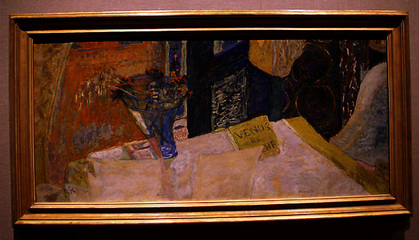

The wondrous all and nothing
The mind often works better on its own, without any prodding or guidance from us. Think of all those ideas that just occurred to you out of the blue, or that problem you solved upon waking up one morning after giving up on it the night before and going to bed.
I was reminded of this recently when my wife and I went to see the exhibition of late still lifes and interiors by Pierre Bonnard at the Metropolitan Museum of Art. We went on a Thursday, but only a few days before the show closed, so it was pretty packed. Worse, a good many of the people in attendance were disinclined to trust their eyes and had attached earphones to their heads so they could have what they were looking at explained to them. (If what they heard was as inane as many of the informational blurbs affixed to the wall beside some of the paintings, they should have asked for their money back. The biographical information was interesting and sometimes even pertinent, but the analytical blather tended to range from the obvious to the fatuous.)

There was, however, something written on the wall that was well worth reading. I almost missed seeing it, but luckily it caught my eye as I was making my way back through the exhibition for a second look. I had just turned away from the wonderful Still Life With Bouquet of Flowers (La Vénus de Cyrène) when I looked up and saw this quote from Bonnard: “I’m trying to do what I have never done, give the impression one has on entering a room: one sees everything and at the same time nothing.”
“Yes,” I said to myself. “That’s exactly what is on display here.” And so I made my way back, reveling in the wondrous all and nothing Bonnard had managed to capture. In the meantime, my mind had automatically made one of those associative leaps it does so well on its own: It reminded me of something I had read on the bus trip to Manhattan. It was in Josef Pieper’s The Silence of St. Thomas: “… it is part of the very nature of things that their knowability cannot be exhausted by any finite intelligence … the very element which makes them capable of being known must necessarily be at the same time the reason why things are unfathomable.”
Great artists do not regard art as an end in itself, but as their means of apprehending reality. Bonnard captures on canvas just what is needed for the viewer to experience the mystery and unfathomability of what Bonnard saw.
Both Bonnard and Thomas Aquinas approach reality from a direction different from that of science. That approach is synthetic, not analytic. It focuses on the richness of effects, not the paucity of ingredients. It is a contemplative approach.
In Poetry and Mysticism, Colin Wilson asks, “Why does a beautiful view often fail to move us, while a painting of the same view immediately touches the aesthetic sense?” His answer is, “Because we automatically slow down the senses to look at a painting.” He notes elsewhere that we do the same thing when we read poetry, or listen to music.
Paradoxically, this slowing down of our senses causes our attention to expand — hence, the everything-and-nothing perspective that Bonnard refers to. The knowledge that art provides is therefore different from what science has to offer. Its focus is on being.
That is why, when we leave an exhibition we usually find that the world outside the museum seems brighter and more interesting than before we entered. We have learned how to see better. And what we see is a world of wonders, a world that casts a spell of silence, permitting the mind to do its best work.
That’s What He Said is published on Tuesdays.
Latest posts by Frank Wilson (Posts)
- An illusion of precision - September 9, 2015
- Watching the passing scene - October 28, 2013
- To see like a child - June 26, 2013
- Riffing and digressions - January 21, 2013
- Life is a parenthesis between one darkness and another - September 13, 2012
 Print This Post
Print This Post




Discussion Area - Leave a Comment